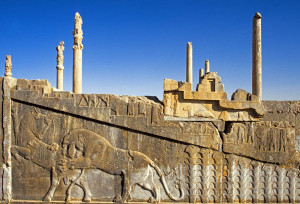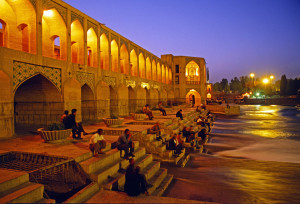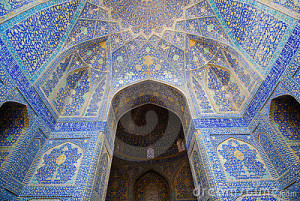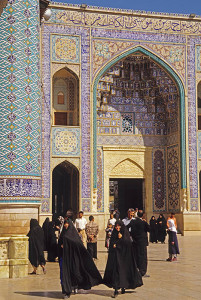With a new nuclear deal in hand (or at least almost in hand, partly depending on U.S. Congressional action), tourism to Iran is expected to soar — much like U.S. tourism to Cuba has reached fever pitch since the recent thaw in relations.
While Iran has received a number of international tourists over the years — including some Americans — since the 1979 revolution brought the ayatollahs to power, economic sanctions have severely crippled Iran’s travel industry.
Still, tourism has been rising somewhat since the election of President Hassan Rouhani in 2013 presented a more moderate face to the world. And with the threat of potential war over Iran’s nuclear program now largely defused, Iran is anticipating a sudden swell of new visitors.
The Iranian government is reportedly considering easing or abolishing visa requirements for many foreign nationals and is overseeing the construction of hundreds of new hotels. The French Accor group is planning to build at least two new four-star hotels in the country, and other hotel groups are entering the market as well.
“The news about the nuclear agreement and lifting of economic sanctions has delighted our tourism industry, said Masoud Soltanifar, Iran’s vice-president for tourism. “No other industry in Iran will see a bigger boost than tourism as the result of this deal.”
Iran is reportedly planning to lengthen tourist visas from 15 days to one month, and perhaps issue visas electronically by 2016.
Iranian officials have expressed hope that within ten years, they can draw up to 20 million visitors annually, about five times the current rate.
Those who have ventured to Iran report a friendly, youthful, well-educated populace that has always been welcoming to Americans, despite the often bitter friction between the two governments. The events of 1979, including the 14-month-long U.S. Embassy hostage crisis, are like ancient history to many of them.
And Iran’s historical and archaeological attractions are among the finest in the world.
UNESCO has recently named two new ancient Iranian sites to its World Heritage list — Susa archaeological mounds and Meymand troglodyte village (occupied for the past 3,000 years) – bringing the country’s total to 19.
Sightseeing gems include the ruins of ancient Persepolis, dating to 518 BC and capital of the once-mighty Achaemenid (First Persian) Empire, founded by Cyrus the Great; Shiraz, the city of literature and flowers; Isfahan, where huge Imam Square is surrounded by mosques and palaces from the 1600s; and Tehran, the capital, which has everything from teeming bazaars to nearby ski resorts.
Visitors can expect to find ancient Zoroastrian religious sites, striking Islamic architecture, high mountains and deep valleys, and small, scenic villages where traditional culture still reigns.
Despite bordering on war zones like Syria and Iraq, where ISIS has found a foothold, Iran is generally safe to visit.
The country is tightly controlled and almost everyone practices the Shia form of Islam, so the country doesn’t face the kinds of Shia-Sunni conflicts that have plagued Iraq and some other Middle Eastern nations.
It should be noted, however, that Iran has detained a number of Americans in the past several years, some for months.
The U.S. State Department’s latest travel warning on Iran, issued in January 2015, reads:” U.S. citizens may be subject to harassment or arrest while traveling or residing in Iran. Since 2009, Iranian authorities have prevented the departure, in some cases for several months, of a number of Iranian-American citizens, including journalists and academics, who traveled to Iran for personal or professional reasons. Iranian authorities also have unjustly detained or imprisoned U.S. citizens on various charges, including espionage and posing a threat to national security.”
Whether or not that will change in light of the breakthrough nuclear agreement remains to be seen. Keep in mind that until (and if) the U.S. re-establishes formal relations with Iran, American citizens can not count on U.S. consulate help when visiting there.

Ruins of Apadana Palace built by Darius the Great in the Persian city of Persepolis. Photo by Dennis Cox/WorldViews
While the country has been known as Iran since 1935, many tour operators still like to refer to it by its old name, “Persia” — which conjures up images of exotically garbed pashas, mesmerizing Sufi dancers, intricate decorative tiles, beautifully woven rugs, and ancient Persian cultural heritage in general – rather than the more contemporary faces of stern ayatollahs.
Tour operators serving Iran include the Seattle, Washington-based Mir Corporation; the UK-based Travel the Unknown and Wild Frontiers; and Iran-based Iranian Tours and the Pars Tourist Agency.
Most baby boomers remember the trauma of the 1979 Iranian hostage crisis clearly and may be put off by the idea of visiting Iran.
My own philosophy is that if an “enemy” country extends an olive branch — as Iran has done in the past two years — it’s better to accept the branch than to reject it.
Governments have to exercise a great deal of caution when dealing with other governments, but travelers operate more on a people-to-people basis. I believe travelers can become the best ambassadors for peace if they find the kind of friendly welcome from Iranian citizens that recent visitors have reported — and tell folks back home about their experiences.
I know that I hope to visit Iran at the earliest possible opportunity.
Readers: You can subscribe to my blog and get notification of every post by simply typing in your email address and clicking on the blue Subscribe button or downloading my free report, How to Ride the Coming Wave of Boomers. Thanks!













2 Responses to Is Iran the New Cuba for Travelers?